#pulp art 1916
Text
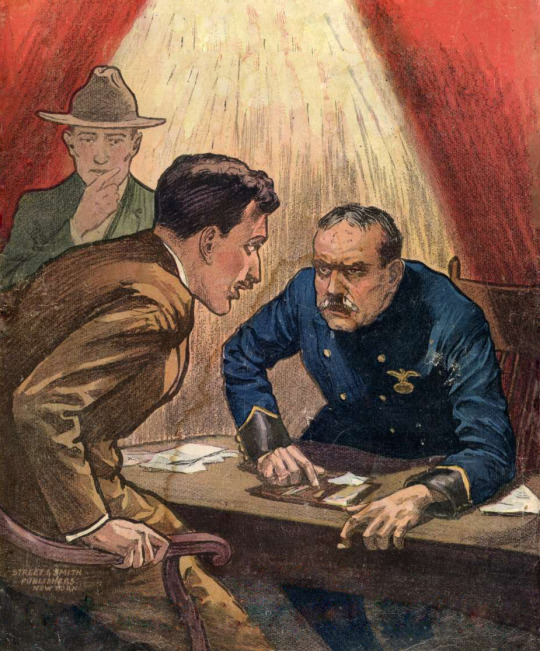
Detective Story Magazine Jan 5 1917
John Coughlin

Detective Story Magazine Aug 5 1916
John Coughlin
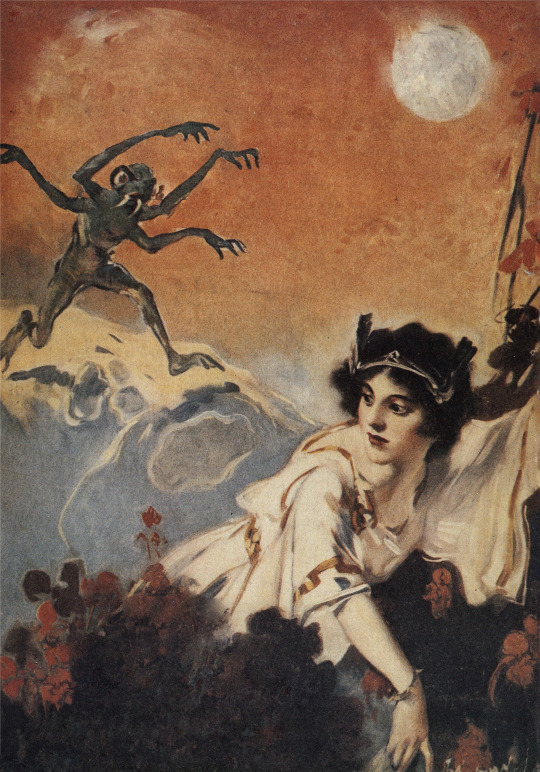
All-Story Weekly Apr 8 1916
Patrick J Monahan
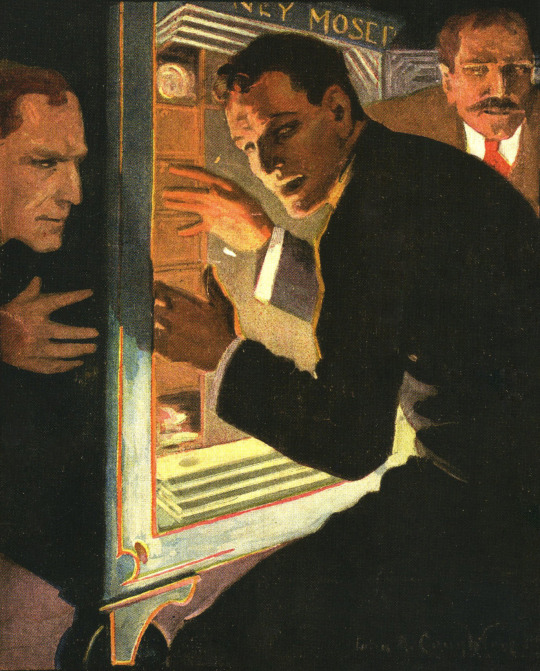
Detective Story Magazine Dec 20 1915
John Coughlin
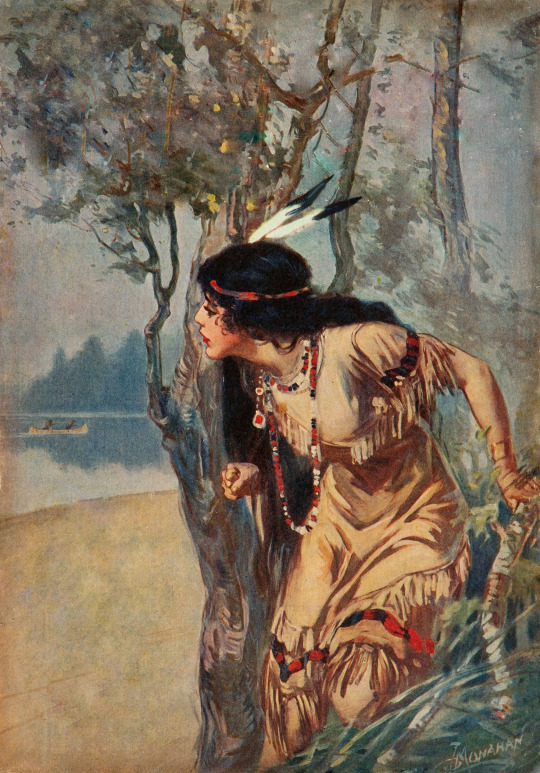
All-Story Weekly Nov 13 1915
Patrick J Monahan
#golden age art#pulp magazine art#pulp art#pulp art 1915#Detective Story Magazine#John Coughlin art#pulp art 1916#pulp art 1917#All-Story Weekly#P J Monahan art#byronrimbaud
1 note
·
View note
Text

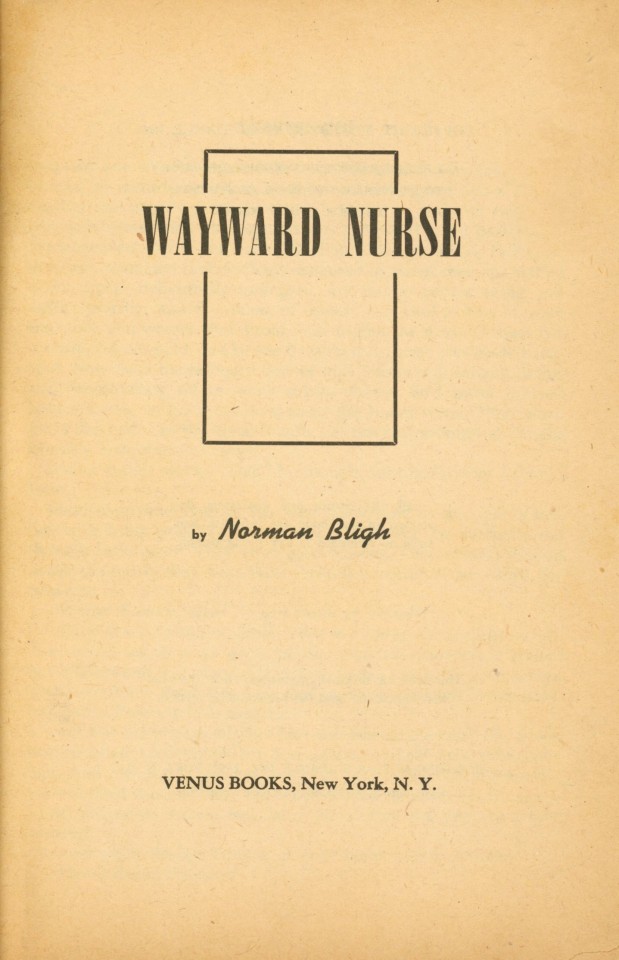
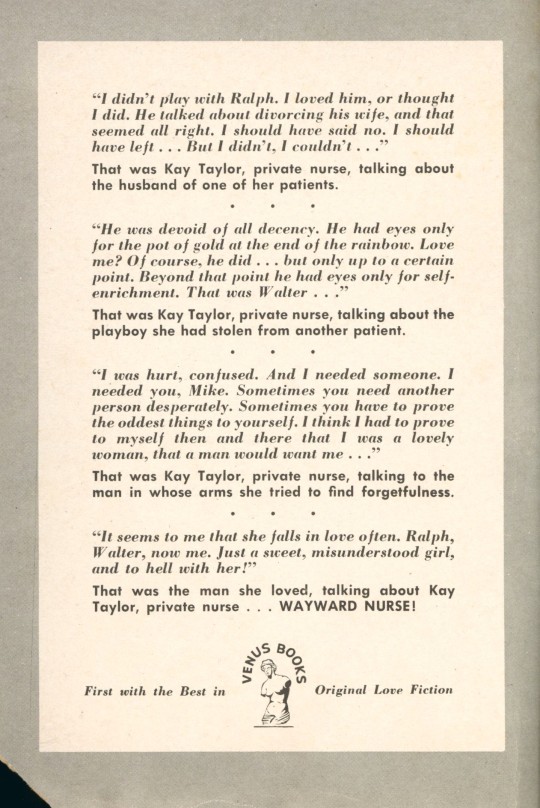

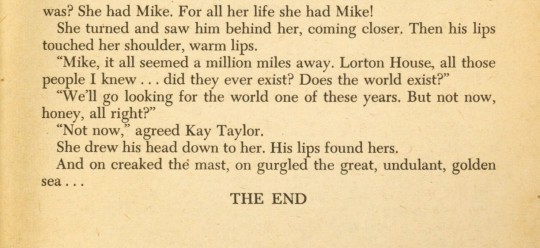
Steamy Saturday
"A private nurse learns the truth about men!"
"A nurse's job is to pamper and please men. . . . But Kay Taylor was too beautiful, too inflammable herself, to soothe any man. . . ."
"Kay needed pampering herself, and as a private nurse, she was able to find it, with the husband of one patient and the sweetheart of another. . . ."
The premise for Wayward Nurse, a Venus Books publication, "first with the best in original love fiction," published by Star Guidance, Inc. in 1953, is about as steamy as it gets. Kay Taylor, a confused and love-hungry private nurse for wealthy clients, plows through one train-wreck romance after another until finally ending up with Mike, "for all her life," on a boat that is apparently being followed by a shark (a metaphor, no doubt) -- "And on creaked the mast, on gurgled the great, undulant, golden sea. . . ." (another suggestive metaphor).
Wayward Nurse, first published in 1952 by another pulp publisher Cameo Books, was written by Norman Bligh, one of the many the pseudonyms of the ultra-prolific pulp novelist William Arthur Neubauer (1916-1982). We think the cover art by noted American magazine and pulp-cover artist Rudolph Belarski (1900-1983) is perhaps the second most provocative cover in our nurse romance collection of over 500 titles. The most provocative will be presented in coming weeks, so stay tuned. And we are just tickled that the publisher made the effort to mention that the highly provocative (for the early 1950s) photograph on the back cover of a couple in their swimsuits (or is it their underwear!) was "Specially posed by professional models" -- as if to say, no nurses were harmed in the making of this photograph. Delightful!
View other nurse romance novels.
View other pulp fiction posts.
#Steamy Saturday#pulp fiction#romance novels#romance fiction#nurse romance novels#nurse romance fiction#nurses#Norman Bligh#William Arthur Neubauer#Wayward Nurse#Venus Books#Star Guidance Inc.#Rudolph Belarski#cover art
29 notes
·
View notes
Text

Silhouette 1916
Man Ray
India ink, charcoal, and gouache on wood pulp board
6 notes
·
View notes
Photo

View of The Art Institute, Childe Hassam, 1916, Art Institute of Chicago: Prints and Drawings
Bequest of William McCormick Blair
Size: 235 x 320 mm
Medium: Watercolor and gouache over graphite, on off-white wove paper, laid down on darkened wood pulp board
https://www.artic.edu/artworks/99750/
10 notes
·
View notes
Photo
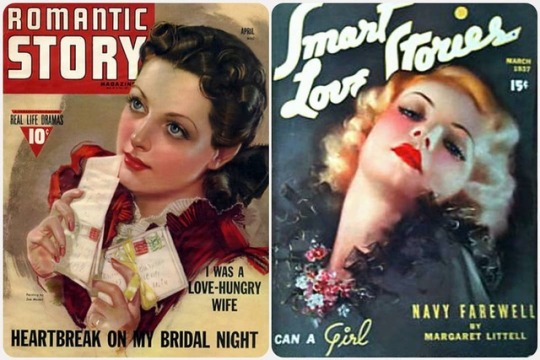
Zoë Mozert (1907 – 1993), was an American illustrator, one of the early 20th century's most famous pin-up artists and models. She was born Alice Adelaide Moser in Colorado Springs, Colorado. Her sister Helen was born in 1915 and brother Bruce was born in 1916. Bruce grew up to be a renowned innovator of underwater photography techniques. In 1921 the family moved to Roaring Brook Township , which is five miles Southeast of Scranton, PA, where her father had been appointed Superintendent of Scranton Stove Works after having invented and patented a new design for a cast-iron stove vent. During her teenage years, with growing prosperity, her family could afford to send her to a prestigious private girl's boarding school in Waynesboro, Virginia, called Fairfax Hall. By 1924 she had completed high school and returned to live with her family near Scranton, PA. She began to study art lessons at the LaFrance Art School, which was a trade school established by a benevolent industrialist, Bernard Davis, who ran the LaFrance Tapestry Mill Company. Another young art student who also attended classes at the same time was John W. Scott. He went on to become a pulp artist and a slick illustrator. From 1925 to 1928 she studied at the Philadelphia Museum School of Industrial Art, where she took advanced classes with Thorton Oakley in 1927 and 1928. The future pulp artist, H. J. Ward, was also a student in that same class. She paid for her tuition by modeling at the school. She most likely also posed for H. J. Ward, several of whose paintings from this time period portray a woman with strikingly similar features. She began her career as an artist in 1927, while working for the Pittsburgh Plate Glass Company. She soon began her own window display business. In 1932 she moved to New York City to look for entry-level freelance work in the magazine industry. Her first illustration jobs were for Bernarr Macfadden's True Story. At this time she adopted a professional name, "Zoe Mozert." According to the artist, "I looked through a name dictionary for a new first name and when there were finally no pages left I settled on Zoe." #destroytheday
2 notes
·
View notes
Photo


He was the author of one of the best-selling books of all time (over 83 million copies sold), and the man who produced the template for Indiana Jones....
Born 164 years ago today, 22nd June 1856, Sir Henry Rider Haggard, was an English writer of adventure fiction set in exotic locations, predominantly Africa, and a pioneer of the lost world literary genre. He was also involved in agricultural reform throughout the British Empire. His stories, situated at the lighter end of Victorian literature, continue to be popular and influential.
Haggard's stories are still widely read today. Ayesha, the female protagonist of She, has been cited as a prototype by psychoanalysts such as Sigmund Freud (in The Interpretation of Dreams) and Carl Jung. Her epithet "She Who Must Be Obeyed" is used by British author John Mortimer in his Rumpole of the Bailey series as the private name which the lead character uses for his wife, Hilda. Haggard's Lost World genre influenced popular American pulp writers such as Edgar Rice Burroughs, Robert E. Howard, Talbot Mundy, Philip José Farmer, and Abraham Merritt. Allan Quatermain, the adventure hero of King Solomon's Mines and its sequel Allan Quatermain, was a template for the American character Indiana Jones. Quatermain has gained recent popularity thanks to being a main character in the League of Extraordinary Gentlemen.
She ......
subtitled: A History of Adventure, was first published 1887, and to date has sold over 83 million copies - to put this in some perspective - War and Peace, The Diary of Anne Frank, The Great Gatsby, Gone with the Wind, and Nineteen Eighty-Four, are within the 30-36 million copies sold range.
She has been adapted for the cinema at least ten times, and was one of the earliest films to be made, in 1899 as La Colonne de feu (The Pillar of Fire), by Georges Méliès with Jehanne d'Alcy as Ayesha. An American 1911 version starred Marguerite Snow, a British-produced version appeared in 1916, and in 1917 Valeska Suratt appeared in a production for Fox which is lost. In 1925 a silent film of She, starring Betty Blythe, was produced with the active participation of Rider Haggard, who wrote the intertitles. This film combines elements from all the books in the series.
A decade later another cinematic version of the novels was released, featuring Helen Gahagan, Randolph Scott and Nigel Bruce. Unlike the book and the other films, this 1935 version was set in the Arctic, rather than Africa, and depicts the ancient civilisation of the story in an Art Deco style, with music by Max Steiner.
The 1965 film She was produced by Hammer Film Productions; it starred Ursula Andress as Ayesha and John Richardson as her reincarnated love, with Peter Cushing and Bernard Cribbins as other members of the expedition.
King Solomon's Mines ......
The novel has been adapted to film at least six times. The first version premiered in 1937, King Solomon's Mines, and was directed by Robert Stevenson. The best known version premiered in 1950, starring Deborah Kerr, Stewart Granger and Richard Carlson.
Haggard wrote the novel as a result of a five-shilling wager with his brother, who said that he could not write a novel half as good as Robert Louis Stevenson's Treasure Island (1883). He wrote it in a short time, somewhere between six and sixteen weeks between January and 21 April 1885. However, the book was a complete novelty and was rejected by one publisher after another. After six months, King Solomon's Mines was published, and the book became the year's best seller, with printers struggling to print copies fast enough.
These are my colourised versions two sepia-toned photographs as below:
Sir Henry Rider Haggard by George Charles Beresford
sepia-toned platinotype, 1902
Jehanne d'Alcy, c. 1900 who played Ayesha (She) in La Colonne de feu (The Pillar of Fire), by Georges Méliès. The role played by Ursula Andress in 1965.
She was portrayed by actress Helen McCrory in Martin Scorsese's 2011 film Hugo
Restoring Your Past … Website
Restoring Your Past … on Facebook
#King Solomon's Mines#she#victorian#Author#Africa#vintage#history#colourised#colorized#photo colourised#photo colorized
1 note
·
View note
Photo

Surcouf, roi des corsaires
French paperback strangely labeled collection “Les Grands Romans Policiers”...tough a common thing at this publishing house “Les Belles Editions” that never indicated any publishing date [but was in the mid/late 30′s] and with whom anything could be stamped “Les Grands Romans policiers”.
This “Surcouf, roi des corsaires” was written by B.Bernard-Lescalier, who signed also Auguste Lescalier for some weird pulp crime stories published as early as 1916.
cover art: J. Saunier
publisher:Les Belles Editions, rue Servan, Paris
source:amsaklapper’s collection
#surcouf#paperbacks#french paperbacks#corsaires#cape & sword#les belles éditions#auguste lescalier#j saunier
7 notes
·
View notes
Photo

View of The Art Institute, Childe Hassam, 1916, Art Institute of Chicago: Prints and Drawings
Bequest of William McCormick Blair
Size: 235 x 320 mm
Medium: Watercolor and gouache over graphite, on off-white wove paper, laid down on darkened wood pulp board
https://www.artic.edu/artworks/99750/
6 notes
·
View notes
Photo

View of The Art Institute, Childe Hassam, 1916, Art Institute of Chicago: Prints and Drawings
Bequest of William McCormick Blair
Size: 235 x 320 mm
Medium: Watercolor and gouache over graphite, on off-white wove paper, laid down on darkened wood pulp board
https://www.artic.edu/artworks/99750/
7 notes
·
View notes
Photo

View of The Art Institute, Childe Hassam, 1916, Art Institute of Chicago: Prints and Drawings
Bequest of William McCormick Blair
Size: 235 x 320 mm
Medium: Watercolor and gouache over graphite, on off-white wove paper, laid down on darkened wood pulp board
https://www.artic.edu/artworks/99750/
7 notes
·
View notes
Photo

View of The Art Institute, Childe Hassam, 1916, Art Institute of Chicago: Prints and Drawings
Bequest of William McCormick Blair
Size: 235 x 320 mm
Medium: Watercolor and gouache over graphite, on off-white wove paper, laid down on darkened wood pulp board
https://www.artic.edu/artworks/99750/
2 notes
·
View notes
Photo

View of The Art Institute, Childe Hassam, 1916, Art Institute of Chicago: Prints and Drawings
Bequest of William McCormick Blair
Size: 235 x 320 mm
Medium: Watercolor and gouache over graphite, on off-white wove paper, laid down on darkened wood pulp board
https://www.artic.edu/artworks/99750/
5 notes
·
View notes
Photo

View of The Art Institute, Childe Hassam, 1916, Art Institute of Chicago: Prints and Drawings
Bequest of William McCormick Blair
Size: 235 x 320 mm
Medium: Watercolor and gouache over graphite, on off-white wove paper, laid down on darkened wood pulp board
https://www.artic.edu/artworks/99750/
0 notes
Text
Sensor Sweep: Rialto’s Market, Castle Amber, Freas, David Drake
Fiction (Goodman Games): Jack Holbrook Vance was summoned into this world just over a century ago in San Francisco on August 28, 1916. A writer of multiple genres, he is best known to fans of Dungeons and Dragons for his Dying Earth novels, one of the inspirations for the magic system, often called ‘Vancian’, in which magic-users memorize spells from their librams, and once cast, forget them for the day.
Gamergate (Walker’s Retreat): Among all the other events of the last week or so was the anniversary of Gamergate. To which I find this Tweet and its pic very much my mood.
Poetry (Kairos): Kipling’s famous–some might say infamous–poem “The Wrath of the Awakened Saxon” has gained a great deal of traction in dissident circles. I maintain that a major reason why this poem has resonated with the current generations of young men on the right is that it highlights the masculine virtues they were never taught.
Fiction (DMR Books): Since April 9, 2018, I’ve been periodically posting blog entries devoted to what I call the “Forefathers of Sword and Sorcery”. Those would be the men—writers like Doyle and London—who influenced the First Dynasty of S&S authors such as Robert E. Howard, Clark Ashton Smith and C.L. Moore. Apparently, there are some very confused people out there on the Webz. I thought it best to define some terms and parameters so further misapprehensions don’t occur.
Art (Rafeeq McGiveron): s July draweth to a close, I suddenly realize that the last month and a half has been pretty busy in terms of updates to my Heinlein cover art galleries. In addition to new-to-me editions of books like Waldo and Magic, Inc., Orphans of the Sky, The Man Who Sold the Moon, Time for the Stars, and Podkayne of Mars, I also have come across quite a bit of things from magazines.
Terry Pratchett (The Wert Zone): Following the publication of yet another publicity image from BBC America’s The Watch, a TV series loosely “inspired by” Sir Terry Pratchett’s Discworld books, his family and associates have once again made it clear that they do not approve of the project and have distanced themselves from it.
Pulp (Pulp Net): I recently obtained The Doc Vandal Omnibus: Vol. 1, which has the first three novels by Dave Robinson featuring Doc Vandal, a steampunk take on Doc Savage. Doc Vandal was influenced by Doc Savage, but also Captain Future and Perry Rhodan. He exists in a different world where aliens exist and other strange things. Born on the Moon and raised by alien AIs, Vandal is an improved human who uses his skills and knowledge to create inventions and stand up against evil.
Gaming (Grognardia): Naturally, we’re not playing these games face-to-face. Instead, we’re making use of VASSAL, a virtual tabletop created for wargamers (specifically Advanced Squad Leader). VASSAL has proven surprisingly easy to use, not to mention fun. Based on my friend’s recommendation, we began my education with GMT’s Falling Sky: The Gallic Revolt Against Caesar. Partly this was done because it’s a period of history I know a bit about and partly because Falling Sky is an entry in GMT’s COIN series, which my friend thought would appeal to me.
History (Legends of Men): A while ago, I picked up an old book on pirates for cheap at a used bookstore. It’s General History of the Robberies & Murders of the Most Notorious Pirates. by Daniel Defoe. You may recognize the name Daniel Defoe as the author of Robinson Crusoe and other novels. He’s one of the first early English novelists, and his authorship of this book is disputed but highly probable. This book is loaded with more than 20 stories of actual pirates, their exploits, successes, failures, and deaths.
Fiction (Benespen): King David’s Spaceship [Amazon link] is the first book by Jerry Pournelle I remember reading. I picked it up from the local library in 2006, and I could not put it down. Colonel Nathan MacKinnie’s desperate quest to find a forgotten database of ancient technology on a barbaric planet, and then spirit that information home under the watchful eyes of the Imperial Navy is a classic adventure. Jerry Pournelle’s style is the place where intrigue, politics, and technology meet, often with a heavy dose of military tactics. King David’s Spaceship is all that and more.
Conan (Conan.com): We’re happy to announce the launch of the official Conan store, called Rialto’s Market, here on Conan.com! It’s headed by the merchant Rialto, someone you’ll learn more about in the near future. We’ve got T-shirts, Thulsa Doom bottle openers, phone cases, mugs, and more for you in Rialto’s Market. You can also pre-order the Conan the Cimmerian: The Tower of the Elephant board game, if you missed out on the successful Kickstarter.
RPG (Pelgrane Press): The term: table sense. It’s what developers look for when you write scenarios or source material for roleplaying games. It’s what game masters need from you when they read your material. Table sense is what it sounds like: the ability to forecast what will happen at the gaming table when the scene, magic item, background detail, monster or whatever it is comes into use. How do you get it? By playing roleplaying games of the sort you’re writing for. And more importantly: by picturing the play experience as you write, away from your table.
Vampirella (Monster Librarian): From the Stars…a Vampiress provides a great reference guide to one of the most recognizable female horror comics heroines, Vampirella. The first section, “The Vampire Who Fell to Earth”, tells her story from her initial creation by James Warren and Forrest J. Ackerman, and other writers and artists who helped her development such as Archie Goodwin, Jose Gonzalez, Trina Robbins, Frank Frazetta, Gonzalo Mayo, and many more, to her cancellation in 1982 after Warren Publishing closed its doors.
Science Fiction (Digital Bibliophilia): Rogue Ship is one the novels Vogt constructed from previously issued stories into a ‘fix-up’ and has a complicated history. From the notes in my 1975 Panther paperback edition it started life as three seperate stories that were rewritten for this single novel. Beginning in 1947, with Centaurus II, which was first published in ‘Astounding Science Fiction’ (which became the magazine ‘Analog Science Fact – Science Fiction’), we then move on to Rogue Ship published in ‘Super Science Fiction’ three years later, and lastly have a story called The Expendables published within the pages of ‘IF Worlds of Science Fiction’ in 1963.
RPG (Goodman Games): It’s time! We’re opening the doors on Original Adventures Reincarnated #5: Castle Amber, and you are all invited inside. The fifth release in our Original Adventures Reincarnated line is now up and available for pre-order from our online store. It’s your chance to get in line for the first wave of shipments of this great new release.
Cinema (Flickering Myth): When The Expendables was first announced in late 2009, my excitement levels went through the roof. Initially it was Sylvester Stallone, Jason Statham and Jet Li on board and that was exciting enough. Then Dolph Lundgren signed on, and the rest followed. By the time a mid-shoot addition of Bruce Willis and Arnold Schwarzenegger was announced (in a surprise cameo where the surprise was blown long before release sadly) I was bouncing around like a toddler high on Dib Dab. The first film came out 10 years ago today.
Cinema (Made in Atlantis): During the 1899 to 1901 Boxer Rebellion, Peking is an open city with the Chinese, and several European countries vie for control. The Boxers, who oppose Christianity and the western powers, who still exercised complete sovereignty over their compounds and their citizens. The head of the U.S. garrison is Marine Major Matt Lewis (Charlton Heston), an experienced China hand who knows local conditions well. He meets exiled Russian Baroness Natalie Ivanoff (Ava Gardner), with whom he falls in love.
Science Fiction (Frank Ormond): I have previously written on my favorite science fiction series, Count to the Eschaton Sequence, before. The first book is Count to a Trillion and is an excellent adventure science fiction novel. This retrospective was a long time coming. I’ve found John C. Wright’s work fascinating, if not a bit verbose in areas, and creative. He’s held up in some circles as a master of the craft, and it’s easy to see why.
Art (DMR Books): The late, great Kelly Freas* would’ve turned ninety-eight today. As I’ve noted elsewhere, Freas started out in Weird Tales and could have had a fine career illustrating fantasy and weird fiction. However, he tied his star to the burgeoning science fiction market and became one of the all-time greats. For me, without question, Freas’ art epitomizes the look of what’s known as the Golden Age of Science Fiction. Gorgeous color, beautiful women, sleek spaceships and a universe blazing with stars.
Comic Books (Comicsradio): Everyone falls in love with Cave Girl. It apparently can’t be helped. Over the course of the first three stories included in Cave Girl #11 (her debut issue despite the numbering), two men have fallen in love with the blonde Jungle Girl already. In fact, in this issue’s final story (still written by Gardner Fox and drawn by Bob Powell), Luke and Alan haven’t given up yet. They are attempting to cross the mountains that surround Cave Girl’s home jungle, still determined to talk her into coming back to civilization and claiming her inheritance.
Anime (Karavansara): As a kid I watched a lot of movies and TV series, cartoons both western and Japanese, I read comics, I read novels and short stories and non fiction… each of these shaped the way I think about stories, and I think it might be fun to try and take a look at all these influences. And I’m starting with anime because… ah, because we need to start somewhere, right? As I probably already mentioned in the past, Italy was at the forefront of the anime invasion that started at the very tail-end of the ’70s.
D&D (Mystical Trash Heap): As a hobby for nerds, there’s a strong appetite among D&D fans to make lists and categorize things, and this extends not just to elements within the game but to meta-level discussion about the game itself. The most obvious breaking point is TSR-D&D (1974-97) and Wizards of the Coast/Hasbro D&D (1998-present), with the 1998-99 period (after Wizards took over but before D&D 3.0 was released) as a transition period. The next most obvious is the various editions: Original (1974-77*), 1st Edition Advanced (1978-88), 2nd Edition Advanced (1989-99), 3rd (2000-2007), 4th (2008-2013), and 5th (2014-present) editions.
Science Fiction (Chapleboro): David Drake almost missed our interview. Although the incident occurred two weeks before we met, Drake was directly involved while riding one of his three motorcycles. As we discussed the crash, Drake casually stated that being rear-ended on his bike was one of the ways he thought he might die. Fortunately, he walked away with nothing more than a few bumps and bruises – not too bad, considering his motorcycle was sandwiched between two SUVs.
Sensor Sweep: Rialto’s Market, Castle Amber, Freas, David Drake published first on https://sixchexus.weebly.com/
0 notes
Text
Sensor Sweep
Science Fiction (Kairos): Congratulations to Analog for coming up with a more concise and even lamer award name than the Montgomery Burns Award for Outstanding Achievement in the Field of Excellence. Then again, that award was created because Burns accidentally emasculated someone. The Astounding Award specifically recognizes emasculation.
Cinema (Walker’s Retreat): This is not just corporate fan fiction. This is everything that fan fiction routinely gets shat upon put forth front and center, and passed off as “original”. Yes, right down to all sorts of contradictory narrative incompetence and Very SMRT Boy signalling. Yes, we get exactly what Rey Sue was going to get at the end: a galaxy where she’s the only Force User, making The Force Is Female a literal fact. We get the last of the Original Trilogy notables dredged up and abused in service to Rey Sue before being removed from the stage.
Gaming (Niche Gamer): Frozenbyte has released another new trailer for their upcoming space sandbox game, Starbase. The new trailer, which you can find above, shows off the physics and mechanics involved in creating your own starships in the game.
Here’s a rundown of the game.
Fiction (Jon Mollison): As part of the on-going effort to challenge indy writers to do better, let’s take a look at two of the most popular guidelines: “Avoid passive voice,” and, “Show don’t tell.” To do so, check out the masterful opening to The Scarlet Citadel, by the king of sword and sorcery, Robert E. Howard.
Television (Wasteland and Sky): Now, am I arguing sitcoms are on the level of high art that have been usurped by pretenders looking for its glorious crown? Hardly. What I’m arguing is that it’s another medium that was usurped and replaced by those who wanted to use it as a weapon, and then destroyed.
Sword and Sorcery (DMR Books): When “The Shadow Kingdom” by Robert E. Howard appeared in the pages of Weird Tales, no one would have guessed that it would continue to provide inspiration for fantasy authors for ninety years and counting. This remarkable story is often pointed to as the beginning of the sword and sorcery genre, although this opinion is not unanimous.
D&D Gaming (Polygon): One of the most delightful surprises of E3 2019 was the announcement of Baldur’s Gate 3. Die-hard fans of Dungeons & Dragons and computer role-playing games in general were ecstatic to learn that Larian Studios, creators of the excellent Divinity: Original Sin franchise, will be handling the project. Those same fans were notably confused, however, by the in-fiction timeline of Baldur’s Gate 3.
H. P. Lovecraft (M.C. Tuggle): How is it possible that the feverish works of a writer who died in poverty and obscurity more than 80 years ago still matter?
And yet they do matter, and to a growing number of fans and admirers. Here are three recent takes on Lovecraft’s continuing popularity, all from vastly different points of view, though they agree Howard Phillips Lovecraft has something to say to modern audiences.
Biography (Gardnerffox.com): This book is far overdue! Why wasn’t this book written twenty years ago? The comic book and pulp paperback industries, primarily American, brought the majority of what the world consumes as entertainment, today. It should go without being said that most of the people creating for these two industries would not have known the impact their work would have on generation upon generation of creatives.
Fiction & RPG (Cirsova): In the past, I’ve made the dangerous claim that good short fiction, like the kind you read in the pulps or in Appendix N, poses a threat to a product-driven OSR whose focus has moved away from systems and into settings materials and modules. My reasoning is that a short story is far easier to digest and build a game around than your typical Gazetteer-style setting product with its oodles of townships, kingdoms, persons of personage, blah blah blah.
RPG (Rlyehreviews): One of the issues with RuneQuest—recently and beautifully republished as RuneQuest Classic by Chaosim, Inc.—was what it hinted at and did not provide. It hinted at a setting, that of Glorantha, which we know of today in all of its richness and detail through numerous roleplaying games and supplements.
Fiction (Adventures Fantastic): Jack Vance was born on this date, August 28, in 1916. We lost him on May 26, 2013. Vance was a master of both science fiction and fantasy. He often wrote in a highly stylistic manner. I first read Vance in The Hugo Winners, edited by Isaac Asimov, when I was a freshman in high school. That volume contained “The Dragon Masters” and “The Last Castle”.
D&D (Skulls in the Stars): As long as I’m still on an old school kick, let me try and catch up with all my posts from twitter! Part 1 of Old School Dungeons & Dragons on the blog can be read here.
Without further ado, here’s part 2! N4: Treasure Hunt (1986), by Aaron Allston. The first thing you may notice when looking at the cover is that this module is unusual in that it is for 0th level characters! What is the deal with that?
Gaming (Postmodern Pulps): Today I just wanted to highlight the wargame I am most invested in on an emotional level – Games Workshop’s Warhammer 40,000. For those who don’t know what it is – I’ll do this REAL QUICK – a bunch of British tabletop miniatures folks had a set of wargaming rules called Warhammer. It had armies of Elves and Dwarfs and guys with swords and pikes, and orcs and goblins, even skeletons and ghouls and “chaos” warriors and monsters.
D&D (Brain Leakage): Last week, I talked a little about the corporate same-y-ness that overtook later editions of D&D, and how it differed from the kitchen sink, anything goes weirdness of 1st Edition AD&D. That post was written largely in response to a recent episode of Geek Gab.
Macabre Science Fiction (Old Style Tales): After 1906 Wells’ speculative fiction output had rapidly dried, and was only sporadic (and never particularly effective, unique, or good) after that point. During the fifteen years that he did write speculative fiction (which, to clarify, includes sci-fi, weird tales, ghost stories, horror, mystery, fantasy, alternate history, apocalyptic fiction, utopian fiction, and paranormal: all genres which Wells contributed in sizeable ways), Wells wrote nearly two dozen short stories of horror and the supernatural, most of which were of high literary merit as well as being entertaining. fter 1906 Wells’ speculative fiction output had rapidly dried, and was only sporadic (and never particularly e, unique, after that point.
Science Fiction (Tellers of Weird Tales): As I have thought more on it, I see that a distinction can be made between two types of projection, speculation, or extrapolation in science fiction:
First are things that don’t change. These are easy to project into the future because what is true today will also be true tomorrow. I’m thinking specifically here of human nature. If you write convincingly about human nature, your story can never be obsolete. Witness the Iliad and the Odyssey, composed nearly three millennia ago and still comprehendible to us today because its people are real.
Tolkien (Alas Not Me): If much of what we have seen in the first three chapters of Book Four traces a descent for Frodo, the next three chapters will show his path turn upward again. For the pity he showed Gollum is Frodo at his best, and confirms the good opinion Gandalf and Bilbo have of him. Soon, though, and in the name of his quest he uses the Ring to dominate a Gollum whom he would not kill and could not set loose.
Fiction (Postmodern Pulps): I wanted to highlight a series of fiction anthologies being put out by Wolfpack Publishing, and curated/edited by Paul Bishop, a retired LAPD detective and venerable novelist. The first anthology, Pattern of Behavior I read as soon as it was released, and while not every one of the stories was entirely my bag, so to speak, all of them were well-crafted tales from highly-talented authors.
Sensor Sweep published first on https://sixchexus.weebly.com/
0 notes